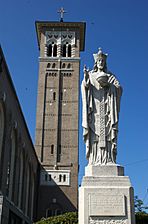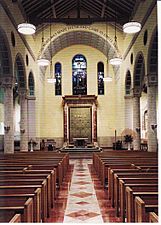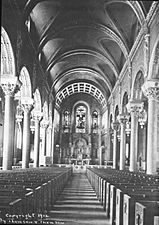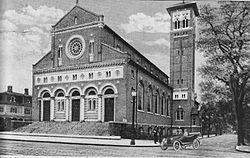St. John the Evangelist Church (Cambridge, Massachusetts) facts for kids
Quick facts for kids St. John the Evangelist Church |
|
|---|---|
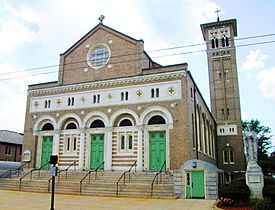
(2017)
|
|
| 42°23′40″N 71°7′38″W / 42.39444°N 71.12722°W | |
| Location | 2254 Massachusetts Ave Cambridge, Massachusetts |
| Country | United States |
| Denomination | Roman Catholic |
| History | |
| Status | Parish church |
| Founded | Parish split from St. Peter's: January 1, 1893 |
| Architecture | |
| Functional status | Active |
| Heritage designation | NRHP |
| Designated | 1983 |
| Architect(s) | Maginnis, Walsh and Sullivan |
| Style | Romanesque Revival |
| Groundbreaking | November 30, 1904 |
| Completed | Early 1905 |
| Administration | |
| Archdiocese | Boston |
St. John the Evangelist Church is a beautiful and historic Roman Catholic church located at 2270 Massachusetts Avenue in Cambridge, Massachusetts. It's a special place that has been important to its community for a long time.
A famous person named Tip O'Neill, who was a Speaker of the House (a very important leader in the U.S. government), grew up attending this church. He even graduated from St. John High School in 1931. His funeral service was held here on January 10, 1994.
The church building was finished in 1904. It was added to the National Register of Historic Places in 1983, which means it's recognized as an important historical site. The architects who designed it, Maginnis, Walsh and Sullivan, were very talented and even won awards for their work, including one for St. John's Church.
Contents
History of St. John's Parish
How the Parish Started
Before the early 1890s, the areas of North Cambridge and West Somerville were part of a different church's area called Saint Peter's parish. People living in these areas had to travel long distances to attend Mass on Sundays.
Because many new industries were growing and more immigrants were moving into the area, the pastor of St. Peter's Parish, Father Flately, became worried. He wanted to make sure that the children in these growing communities could get a good Catholic education. So, in 1890, he bought a piece of land on Spruce Street (which is now Rindge Avenue).
On January 1, 1893, St. John's Parish officially became its own independent church community. At first, they held their services in a small wooden chapel on Rindge Avenue.
Building the New Church and Rectory
In 1898, the church bought land at the corner of Massachusetts Avenue and Hollis Street for $18,000. This was where they planned to build the new, bigger church. The old house on that land, called the Locke house, was moved to 8 Hollis Street and became the second rectory (the house where the priests live).
Later, in 1930, the third and current rectory was built. It's made of yellow brick and is located at 2254 Massachusetts Avenue. This building has a unique style with Moorish-style windows. The old rectory at 8 Hollis Street was then torn down.
In 1933, for a special "Holy Year," the church used a beautiful monstrance for a Holy Hour. A monstrance is a special container used to display the Eucharist. This one was made of gold, silver, diamonds, and other precious stones, donated by the church members. It was said to be the largest monstrance in the United States at that time.
Church Architecture and Design
Building the Main Church
Work on the new church building started on November 30, 1904. The famous architects Maginnis, Walsh & Sullivan designed it, and Stephen Brennan was the builder. The main architect, Charles Donagh Maginnis, was inspired by other well-known architects like Ralph Adams Cram and H. H. Richardson, who designed Trinity Church, Boston.
The city's building permit described the church as being built with brick, stone, and iron. The first stone, called the cornerstone, was laid in 1905. The very first Mass was held in the new church on April 7, 1912, which was Easter Sunday. On November 1, 1912, the church was officially dedicated by Cardinal O'Connell. Even though many Irish immigrants helped build the church, its design was inspired by 12th-century churches in Italy, especially the Basilica di San Zeno in Verona.
Inside the Church and Stained Glass
The inside of the church uses cream-colored limestone and marble, which gives it a look similar to Italian buildings from the Middle Ages. The design uses both round and pointed arches, which is a style found in Italian Gothic design. The pointed arches were mostly for decoration. This basic building style was used in ancient Greek and Roman temples and later in Christian churches.
The stained glass windows along the side walls have soft, muted colors. These colors are like those found in sunny Italy, rather than the darker windows often seen in France and Germany. The beautiful main altar is located under a stunning stained glass window that shows the Crucifixion (Jesus on the cross). On one side, there is a side altar dedicated to the Sacred Heart of Jesus, and on the other side, one dedicated to the Blessed Virgin Mary.
Bell Tower, Rose Window, and Bells
One of the most striking parts of the church is its Campanile, which is another name for a bell tower. It stands a bit behind the front of the church and is separate from the main building, so it doesn't block the view of the front. The top of the tower has a Byzantine design, similar to churches in the Ravenna region of Italy. It was unusual for this style to place the tower towards the back of the building.
The bells in the tower ring every 15 minutes and chime the hour, playing the famous Westminster Chimes. The front of the church has wide stone stairs that stretch across the entire width of the building. The lower part of the front has five arches supported by marble columns. Above these arches is a decorative band of terra cotta. Above that is a large rose window, which is an exact copy of a church window in Toscanella, Italy. This "Wheel of Fortune" window represents never-ending life and looks like the sun. At the very top of the front of the church, there used to be a statue of John the Evangelist.
Fire and Rebuilding Efforts
On December 7, 1956, the church had a terrible fire. The roof collapsed into the main part of the upper church, called the nave, and the choir loft also fell. The side windows were saved but were taken out during the rebuilding. A large part of the upper church was torn down in February 1957.
Rebuilding began in April of that year. The main altar was completely rebuilt, though the original steps leading to the altar area were saved. The altar rail and pulpit (where sermons are given) were left untouched. However, because there wasn't enough money, some parts were not rebuilt. The clerestory (the upper part of the wall with windows), its upper windows, and a walkway were removed. The statue of St. John was also not put back, and the large rose window was replaced with a smaller one. Above the main altar, there are words from the Gospel of John: "And the word was made flesh and came to dwell among us."
Updates in the 1990s
In 1996, the church started a fundraising effort to renovate and update the building. Besides needed repairs, the church also made changes to its worship space to follow updates made by the Second Vatican Council.
The marble main altar was moved forward from its original spot. This allowed it to be used in a new way for Mass, following the changes from the Vatican Council. The altar rail was removed to make the altar area feel more open and welcoming. The old pulpit was taken down and reshaped into a new ambo, which is where readings are done during Mass. Much of the marble from the old altar rail and pulpit was used to create a new baptismal font.
Two statues, one of St. John the Evangelist and one of Saint Joseph, which had been placed near the altar after the fire, were moved, repainted, and placed near the front entrances of the church. The two side altars were also painted to highlight their beauty. The church's tabernacle, where the Eucharist is kept, was moved back to its original place and restored. During this renovation, the church was also made accessible for people with disabilities. The newly renovated church was dedicated by Cardinal Bernard F. Law on December 27, 1998, which is the feast day of St. John the Evangelist.
Mass Schedule
- Saturday Vigil: 4:00 p.m.
- Sunday: 9:00 a.m. & 11:00 a.m. (and 4:30 p.m. in Creole)
- Daily Mass: Monday—Wednesday 12:10 p.m.
- Friday Communion Service: 7:00 a.m.
- Holy Days of Obligation: As announced.
Gallery
See also
- Charles Donagh Maginnis
- Roman Catholic Archdiocese of Boston
- National Register of Historic Places listings in Cambridge, Massachusetts



